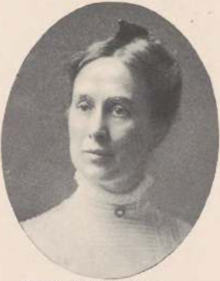Mary Gilmore Williams
Mary Gilmore Williams (June 9, 1863 – May 30, 1938) was an American college professor who taught Greek at Mount Holyoke College from 1898 to 1929, and wrote a study of Roman empresses.
Early life and education[edit]
Mary Gilmore Williams was born in Urbana, New York and raised in Corning, New York, the daughter of Francis Asbury Williams and Letitia Jane Clark WIlliams.[1] Her father was an attorney.[2]
Williams graduated from Mount Holyoke Seminary in 1885.[1] In 1897 Williams completed doctoral studies at the University of Michigan, where she was the first woman student awarded the Elisha Jones Classical Fellowship,[3][4] and one of the first women to receive a Ph.D. at Michigan.[5] She pursued post-doctoral studies at the American School for Classical Studies in Rome.[6][7]
Career[edit]
Williams taught Latin at Kirkwood Seminary and at Lake Erie College from 1889 to 1894. She taught Greek at Mount Holyoke College from 1898, became a professor in 1902, and was head of the Greek department when she retired in 1929.[8][9] She wrote a study of the lives of Roman empresses Julia Domna and Julia Avita Mamaea, which was published in 1902,[10] and is still cited in classical scholarship, over a century later.[11] She was a member of the Archaeological Institute of America, the American Philological Association, and the Classical Association of New England (CANE).[12][13]
Personal life[edit]
Williams lived with her mother and brother in Corning for much of her adult life. She died there in 1938, aged 74 years, and her grave is in Corning's Hope Cemetery.[8]
References[edit]
- ^ a b Leonard, John William (1914–1915). "Woman's who's who of America : a biographical dictionary of contemporary women of the United States and Canada". HathiTrust. p. 889. Retrieved June 24, 2021.
- ^ "Francis A. Williams". Democrat and Chronicle. December 22, 1901. p. 1. Retrieved June 24, 2021 – via Newspapers.com.
- ^ Shaw, Wilfred B. (2000). The University of Michigan, an encyclopedic survey. University of Michigan. p. 1860.
- ^ "JONES, Elisha". Database of Classical Scholars, Rutgers University. Retrieved June 24, 2021.
- ^ Bordin, Ruth (1999). Women at Michigan: The "dangerous Experiment," 1870s to the Present. University of Michigan Press. p. 25. ISBN 978-0-472-08793-8.
- ^ "Among the Colleges". The Daily Chronicle. November 30, 1895. p. 4. Retrieved June 24, 2021 – via Newspapers.com.
- ^ "Untitled social item". Star-Gazette. July 2, 1897. p. 5. Retrieved June 24, 2021 – via Newspapers.com.
- ^ a b "DR. MARY WILLIAMS, PROFESSOR OF GREEK; Retired Mt. Holyoke Educator Is Dead at 74". The New York Times. June 1, 1938. ISSN 0362-4331. Retrieved June 24, 2021.
- ^ "To Meet in Rutland". Swanton Courier. October 2, 1919. p. 1. Retrieved June 24, 2021 – via Newspapers.com.
- ^ Williams, Mary Gilmore (1902). "Studies in the Lives of Roman Empresses". American Journal of Archaeology. 6 (3): 259–305. doi:10.2307/496790. ISSN 0002-9114. JSTOR 496790. S2CID 193125127.
- ^ Tuori, Kaius (May 3, 2016). "Judge Julia Domna? A Historical Mystery and the Emergence of Imperial Legal Administration". The Journal of Legal History. 37 (2): 180–197. doi:10.1080/01440365.2016.1191590. ISSN 0144-0365. S2CID 147778542.
- ^ Williams, Mary Gilmore (April 1926). "An Address in Memoriam" (PDF). Annual Bulletin of the Classical Association of New England. 21: 8–9.
- ^ "Classicists to Meet". Boston Evening Transcript. November 5, 1914. p. 16. Retrieved June 24, 2021 – via Newspapers.com.

